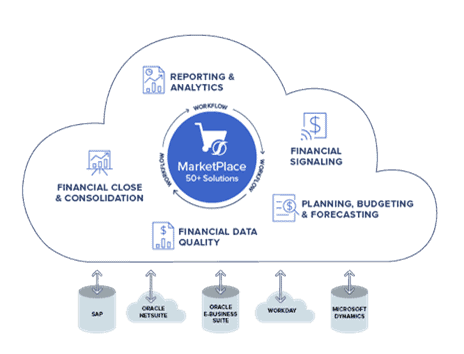Improve Collaboration in Higher Ed via Budgeting and Planning Software

The health of any multifaceted organization depends on multiple teams working in unison, with several sources of data in real-time. In this post, we’ll take a quick look at how the right technology can boost your team’s ability to collaborate quickly and accurately – all through the lens of higher ed budgeting and planning software.
There’s nothing simple about budgeting and planning in higher education. It’s a matrix. How, exactly? Well, simply put, there are just too many moving parts, too many external variables, and too many stakeholders for these two foundational activities to be linear. As today’s increasing pace of change places ever more pressure on Finance teams, many are taking steps to modernize their static budgeting and planning cycles.
Successful Planning and Budgeting Depends on Massive Collaboration
You’d be hard-pressed to find a regent, president, provost, dean, or any other higher-ed leader who didn’t list collaboration as a core value. Educational institutions have an inherent interdependence and must have all their organizational units in sync, working together, to accomplish large goals (see Figure 1). For that reason, access to and collaboration with quality data is imperative at every level of the organization.

Figure 1: The Importance of Data Sharing and Collaboration Source: HBR Analytic Services, 2020
The collaboration gap in budgeting and planning often begins and ends with the segregated nature of internal systems and, more importantly, how those systems share data and edits. Any team emailing around versions of spreadsheets and documents with edits and notes knows this pain all too well.
If those teams are printing hard copies and editing with sticky notes – a practice that’s still surprisingly common – then that pain may even be worse. Essentially, working separately and consolidating along the way creates openings for errors and destroys any hope for a quick, accurate turnaround.
Manual Processes Producing Static Budgets and Plans Don’t Work Anymore
Spreadsheets aren’t equipped to handle the multiple layers of work happening within the flurry of activity known as budgeting and planning in higher ed.

Figure 2: Problems Caused by Spreadsheet Collaboration Reach Far and Wide Source: MarketWatch, “88% of spreadsheets have errors”
In fact, budgeting and planning teams are expected to turn edits, integrate new data and structures, keep up to date, and communicate more clearly than ever before. Here are just a few of the top challenges that bog down budgeting and planning efforts when they’re rooted in manual updates through spreadsheets:
- No Version Control. Have you ever been working on a big project where your teammates sent you multiple emails with an attachment that had the same name? Did you know which one you were supposed to use, without wasting time looking back through the entire chain of exchanges?
- No Audit Trail. When you’re exchanging files, how do you remember who changed what? Do you remember when they changed it?
- Too Many Errors. Have you been tasked with preparing the final output? While you were re-typing edits from the separate notes and spreadsheets into the final output (was that really the “final”… or “final2″…), did you accidentally mistype a number? We’ve all been there, and we’ve all spent hours scouring the source sheets to find the correct entry. Worse yet, what if you missed the error altogether, and the final output is incorrect when it’s delivered to leadership?
- Slow Turnaround. Everyone hates deadlines, but speed is important when you’re making strategic decisions. Have you ever pushed to deliver on time, finished your work, and only later learned that leadership was disappointed that the output you delivered was out of date compared to the information they just heard on the news or read about in a legislative update? If your knowledge and data can’t update in real-time to your outputs, how can you be sure you’re making good decisions?
The hidden costs of spreadsheets are created by duplication of effort, errors, and rework. All this wasted time moves your team’s focus away from the true value of analysis and communication that supports strong decision-making across the institution and keeps everyone stuck in busywork.
As the pace of change continues to increase, higher ed Finance teams need to shift focus away from data gathering, reconciling, and managing key integration points and into collaborating with decision-makers and providing better, faster insights.
Moving Forward with Confidence
At OneStream, we understand that complexity is the inevitable by-product of change, especially in higher ed. Accordingly, we believe that your success will not be realized by eliminating complexity but will instead be achieved by effectively steering your institution through it.
How do we do it? Our unified Intelligent Finance platform (see Figure 3) allows us to deliver our many capabilities within a single, extensible, cloud-based application built to scale along with your organization. That’s why hundreds of organizations, including many higher ed institutions, have chosen OneStream – and they’ve never looked back.

Why is unification important? Well, it eliminates openings for errors created by manual work and separate, connected financial reporting tools. If you re-type data or are dependent on technical connection points for updates, you have opened the door for potential problems.
What can a platform approach do for you and your team? Here are a few of the key benefits you get with OneStream’s budgeting and planning software:
- Improved collaboration as all teammates have access to the data they need and can clearly communicate edits, additions, and corrections.
- Increased trust as the team works from a single source of truth updated in real-time. · Increased accuracy as the data automatically updates across all planning forms, visualizations, and dashboards.
- Increased consistency as the platform provides flexibility but also holds true to administrative structures.
- Reduced delivery time on final outputs.
Learn More
Need some proof? How about a great example from one of the nation’s top 10 public research universities? This case study details how OneStream has helped reduce the time needed to complete budgets and has detailed ROIs, including how a regular existing 3.5 hour-process was reduced to just 5 minutes.
Want to continue the discussion? Have any questions? Contact us, and one of our experts will reach out to you ASAP.
Get Started With a Personal Demo

